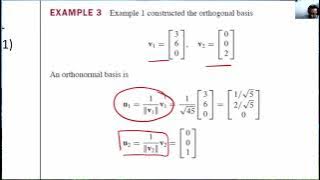
From playlist Linear Algebra Ch 6

Linear Algebra: Continuing with function properties of linear transformations, we recall the definition of an onto function and give a rule for onto linear transformations.
From playlist MathDoctorBob: Linear Algebra I: From Linear Equations to Eigenspaces | CosmoLearning.org Mathematics

Quaternion algebras via their Mat2x2(F) representations
In this video we talk about general quaternion algebras over a field, their most important properties and how to think about them. The exponential map into unitary groups are covered. I emphasize the Hamiltionion quaternions and motivate their relation to the complex numbers. I conclude wi
From playlist Algebra

Cohl Furey on the Octonions and Particle Physics
Cohl Furey explains what octonions are and what they might have to do with particle physics. Read the full article: https://www.quantamagazine.org/the-octonion-math-that-could-underpin-physics-20180720/ Video by Susannah Ireland for Quanta Magazine https://www.quantamagazine.org/ Facebook
From playlist Inside the Mind of a Scientist

Cohl Furey on the Octonions and Particle Physics (lower volume)
Cohl Furey explains what octonions are and what they might have to do with particle physics. Read the full article: https://www.quantamagazine.org/the-octonion-math-that-could-underpin-physics-20180720 Video by Susannah Ireland for Quanta Magazine https://www.quantamagazine.org/ Facebook:
From playlist Inside the Mind of a Scientist

Could These Numbers Unravel New Dimensions in Space?
These multidimensional number systems are helping us explain the laws of nature. Here’s how. Can Hawking’s Black Hole Paradox Be Solved With Fuzzballs? - https://youtu.be/esPa1tVSjew Read More: The Peculiar Math That Could Underlie The Laws of Nature https://www.quantamagazine.org/the-
From playlist Elements | Season 4 | Seeker

Lie Groups and Lie Algebras: Lesson 2 - Quaternions
This video is about Lie Groups and Lie Algebras: Lesson 2 - Quaternions We study the algebraic nature of quaternions and cover the ideas of an algebra and a field. Later we will discover how quaternions fit into the description of the classical Lie Groups. NOTE: An astute viewer noted th
From playlist Lie Groups and Lie Algebras

Now that we know what a quotient group is, let's take a look at an example to cement our understanding of the concepts involved.
From playlist Abstract algebra

Duality in projective geometry is a well-known phenomenon in any dimension. On the other hand, geometric triality deals with points and spaces of two different kinds in a sevendimensional projective space. It goes back to Study (1913) and Cartan (1925), and was soon realizedthat this pheno
From playlist Algebra

From playlist Linear Algebra Ch 6

From Hamilton’s Quaternions to Graves & Cayley’s Octonions – Louis Kauffman
We describe geometric and topological approaches to Hamilton's Quaternions and to the Octonions of Graves and Cayley.
From playlist G4G12 Videos

Group Definition (expanded) - Abstract Algebra
The group is the most fundamental object you will study in abstract algebra. Groups generalize a wide variety of mathematical sets: the integers, symmetries of shapes, modular arithmetic, NxM matrices, and much more. After learning about groups in detail, you will then be ready to contin
From playlist Abstract Algebra

Étienne Ghys: A guided tour of the seventh dimension
Abstract: One of the most amazing discoveries of John Milnor is an exotic sphere in dimension 7. For the layman, a sphere of dimension 7 may not only look exotic but even esoteric... It took a long time for mathematicians to gradually accept the existence of geometries in dimensions higher
From playlist Abel Lectures

Algebraic Topology - 12.2 - Fiber Bundles
From playlist Algebraic Topology

Beauty and Truth in Mathematics; a Tribute to Albert Einstein and Hermann Weyl - Sir Michael Atiyah
Sir Michael Atiyah Institute for Advanced Study November 8, 2010 For more videos, visit http://video.ias.edu
From playlist Mathematics

RNT1.4. Ideals and Quotient Rings
Ring Theory: We define ideals in rings as an analogue of normal subgroups in group theory. We give a correspondence between (two-sided) ideals and kernels of homomorphisms using quotient rings. We also state the First Isomorphism Theorem for Rings and give examples.
From playlist Abstract Algebra

Dihedral Group (Abstract Algebra)
The Dihedral Group is a classic finite group from abstract algebra. It is a non abelian groups (non commutative), and it is the group of symmetries of a regular polygon. This group is easy to work with computationally, and provides a great example of one connection between groups and geo
From playlist Abstract Algebra

9.999... reasons that .999... = 1
Point Nine Repeating Equals One! 9.999... reasons in 9.999... minutes. Bonus points if you can name all 9.999... lords a-leaping. Dear YouTube, wouldn't it be nice if I could include the full script with this video? A larger character limit would not be unreasonable. My personal website
From playlist Doodling in Math and more | Math for fun and glory | Khan Academy